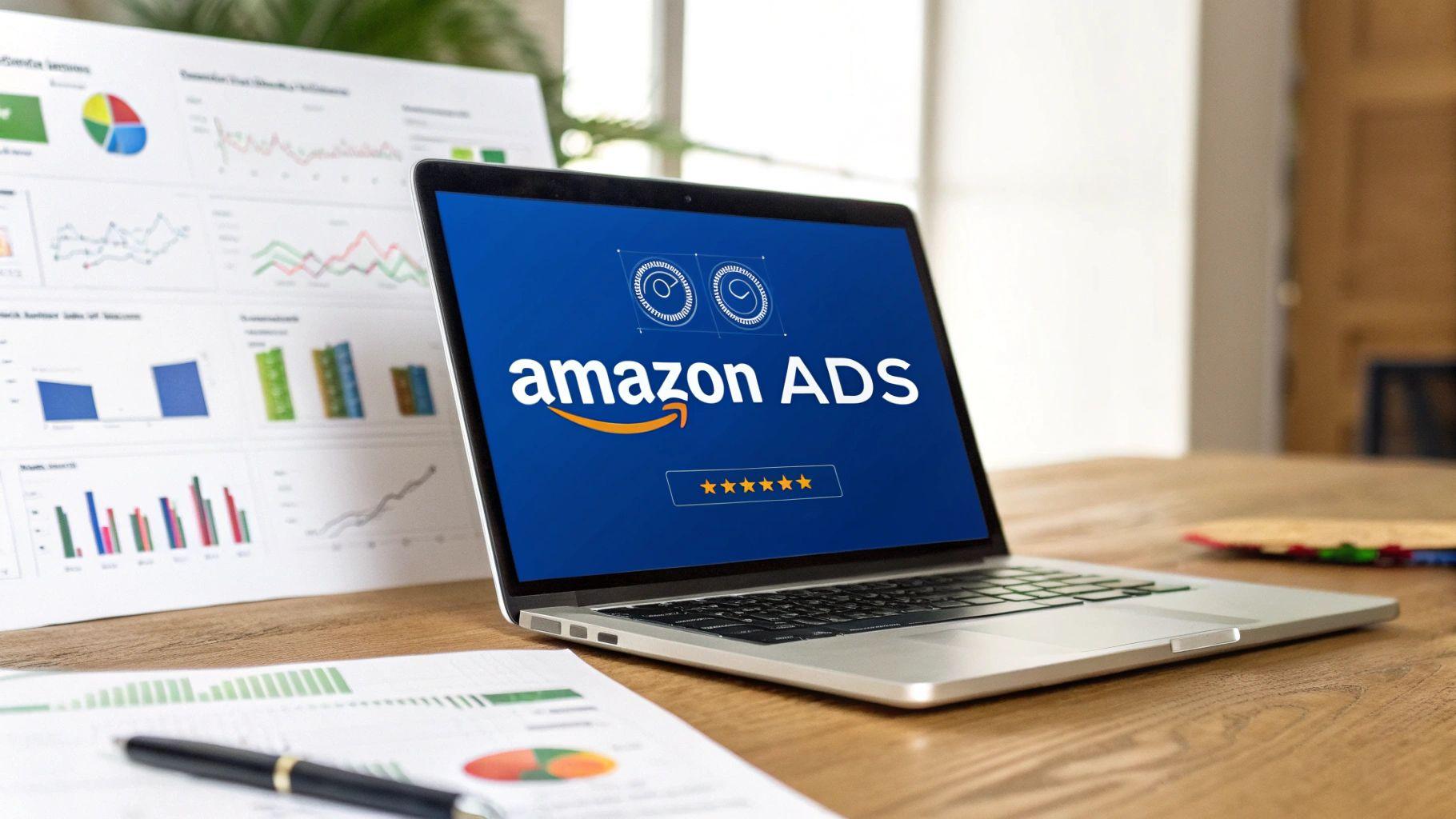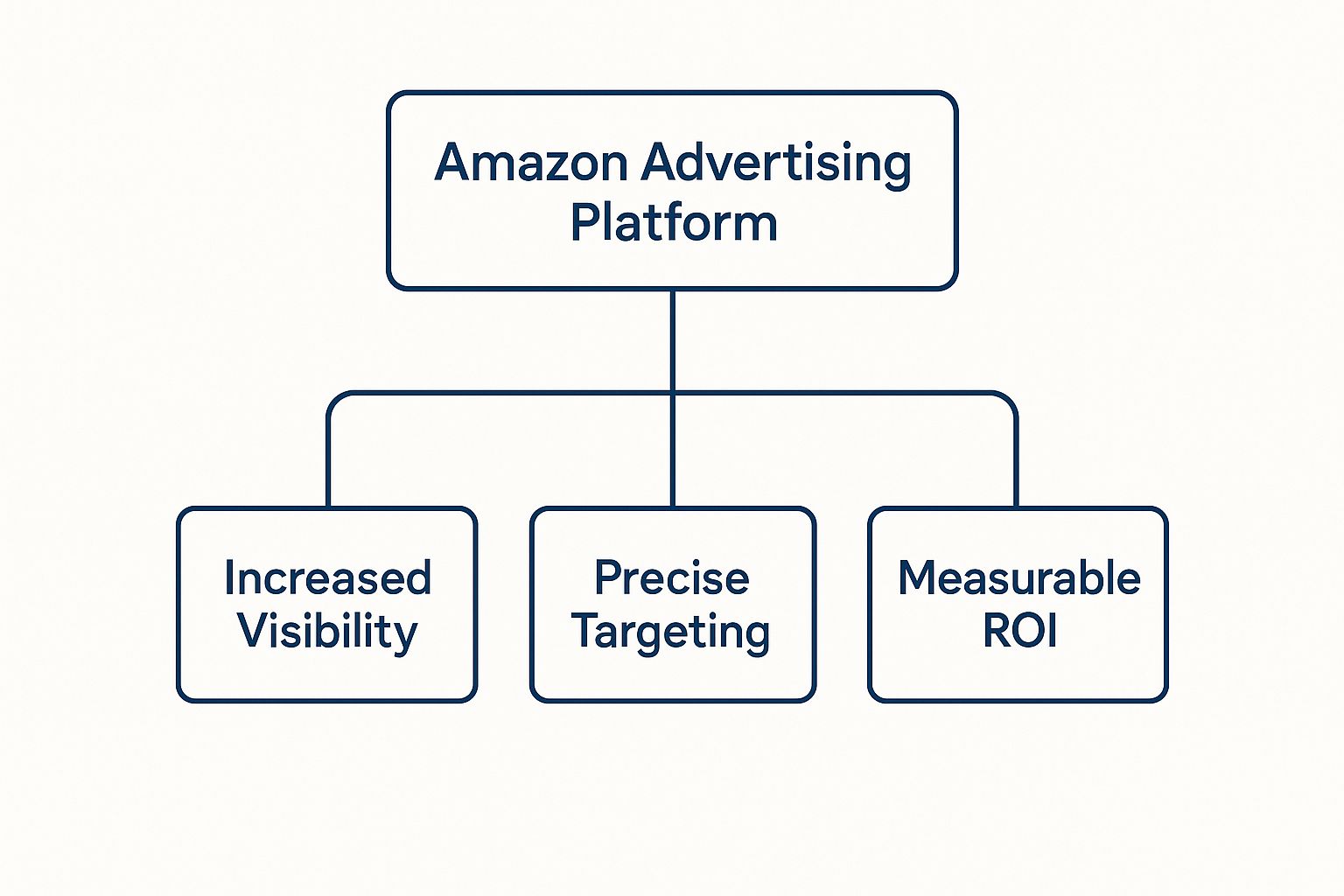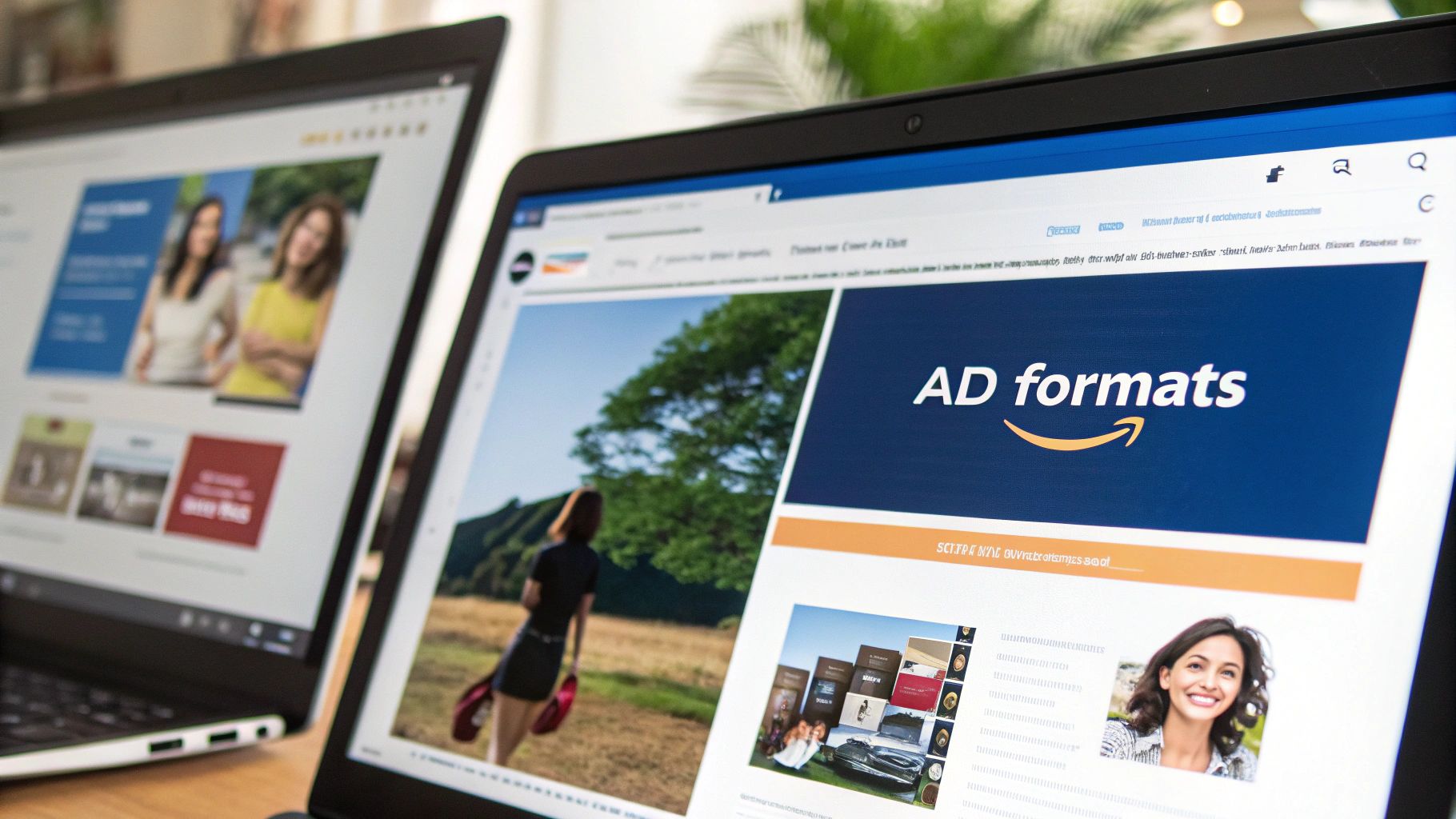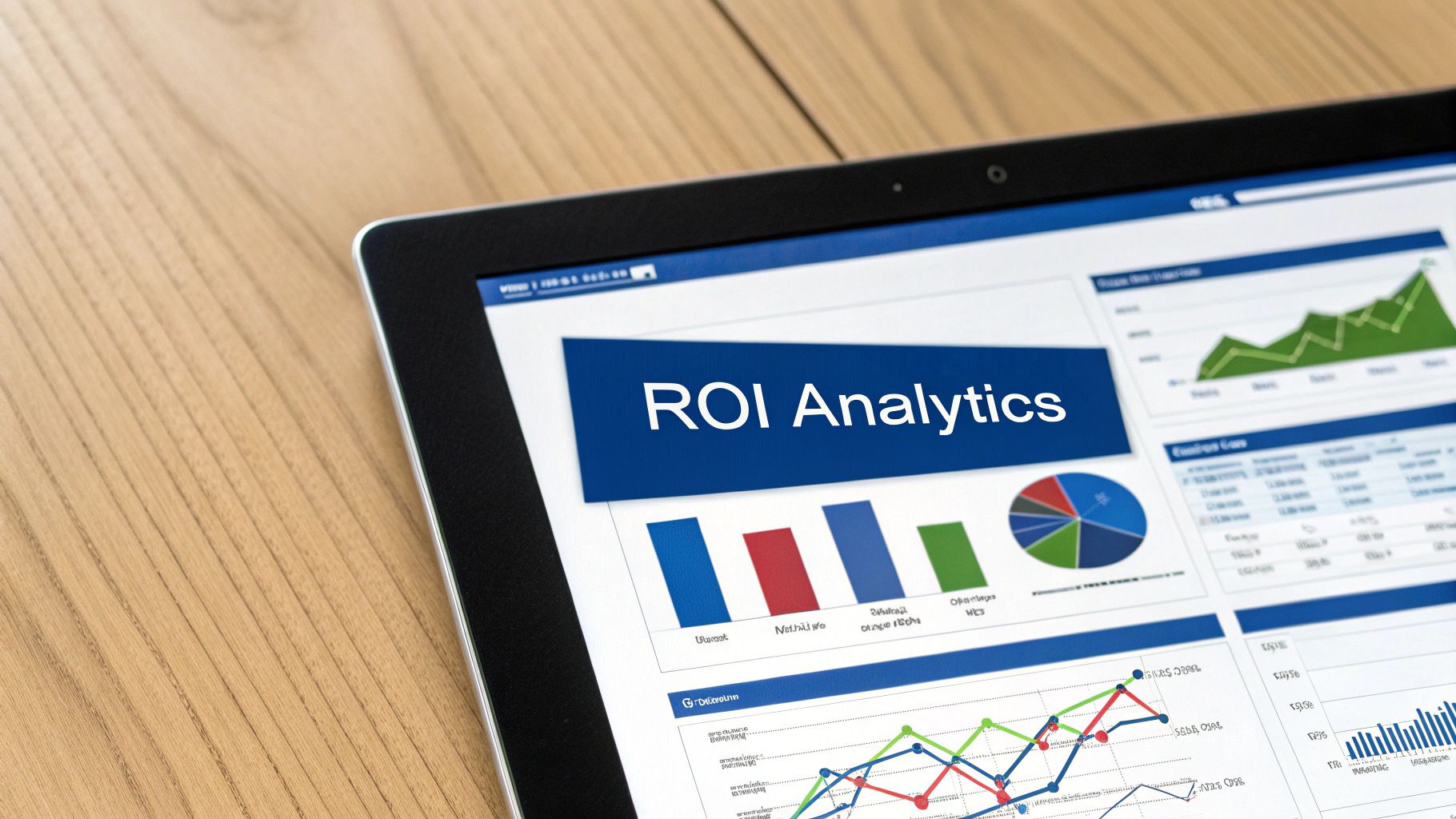Mastering the Amazon Advertising Platform for Profitable Growth
Master the Amazon Advertising Platform with our guide. Learn proven strategies for Sponsored Ads and DSP to drive profitable growth and boost organic rank.

Viewing the Amazon advertising platform as just another line item on your marketing budget is a critical strategic error. For eCommerce and retail leaders, this isn't simply a tool to buy clicks; it's the primary lever for driving organic growth, cementing profitability, and achieving sustainable scale on the world's largest marketplace.
A performance-first approach treats every ad dollar as a direct investment in your product’s long-term health, its organic search ranking, and its defensible market share.
Why Amazon Advertising Is Your Growth Engine, Not Just an Expense
Too many brands get stuck in a transactional mindset: spend money, get clicks, hope for sales. This view misses the point entirely. The brands that dominate their categories understand that the Amazon advertising platform is one of the most powerful tools available to influence the A9 algorithm.
The A9 algorithm is Amazon's complex system for determining which products surface first in organic search. Your ad spend is high-octane fuel for this engine. A well-executed ad campaign doesn't just generate a sale today; it feeds the A9 algorithm critical performance data, like sales velocity and conversion rates, that pays dividends for months to come.
Every ad-driven sale sends an undeniable signal to Amazon: shoppers want this product. This prompts the algorithm to reward you with higher organic placement, which is where true profitability is unlocked.
The Flywheel Effect in Action
This creates a powerful, self-sustaining growth loop known as the "flywheel effect"—a simple concept with profound implications for your brand's trajectory.
Here’s the performance breakdown:
- Paid Clicks Drive Sales: Your ads place your product in front of high-intent buyers, generating crucial initial sales velocity.
- Sales Improve Organic Rank: That sales velocity signals relevance to the A9 algorithm, pushing your product higher in organic search results. A recent case study showed a brand in the competitive supplements space achieved a 47% increase in organic rank for its top 10 keywords after a targeted 8-week Sponsored Products push.
- Higher Rank Drives Organic Sales: As you climb the rankings, you capture more free traffic and sales, reducing your dependency on paid clicks.
- Increased Revenue Funds More Ads: You can then reinvest the profits from both paid and organic sales back into your ad campaigns, spinning the flywheel faster.
This virtuous cycle is what separates market leaders from sellers perpetually stuck paying for every click. Your ad spend transforms from a temporary cost into a lasting competitive advantage. To execute this, you need a complete Amazon advertising strategy that integrates every component toward this goal.
More Than an Ad Platform, It's a Data Goldmine
The sheer scale of Amazon's ad business underscores its strategic importance. Projected to surpass $60 billion in 2025, its ad revenues hit $15.69 billion in Q2 2025 alone, accounting for over 9% of the company's total revenue.
This growth is fueled by brands battling for top-of-search placement, but the smartest ones are looking beyond the bid.
The real objective isn't just chasing a low ACoS. It's about using paid advertising to systematically elevate your organic sales baseline, building a more profitable and defensible business for the long term.
For any brand serious about winning on Amazon, mastering this ecosystem is non-negotiable. It demands a performance-first approach that balances immediate returns with long-term brand equity.
Choosing the Right Ad Types for Your Goals
Diving into Amazon Advertising without a clear strategy is like trying to build a house with top-of-the-line tools but no blueprint. The key to maximizing every ad dollar is matching the right ad type to the right business goal.
A common mistake is applying a single KPI—usually ACoS—across all campaigns. This approach is fundamentally flawed. Sponsored Products, Sponsored Brands, and Sponsored Display are not interchangeable; they are specialized tools designed to engage shoppers at distinct stages of the buying journey.
This diagram breaks down how a smart, layered approach to the platform can pay off in a big way.

As you can see, it all boils down to driving success through a cycle of visibility, sharp targeting, and performance data that gives you a clear, measurable return on your investment.
To make this crystal clear, let's break down how each of the main ad types works in the real world.
Amazon Ad Types Strategic Application Guide
This table provides a quick-glance guide for aligning your advertising strategy with core business objectives. Think of it as a cheat sheet for deploying the right ad for the right job.
| Ad Type | Primary Business Goal | Best Use Case | Primary KPI |
|---|---|---|---|
| Sponsored Products | Drive immediate sales | Capturing high-intent shoppers actively searching for your product or similar items. Great for new launches. | ACoS (Advertising Cost of Sale), ROAS |
| Sponsored Brands | Build brand awareness | Dominating top-of-search results, defending against competitors, and driving traffic to your Amazon Store. | New-to-Brand Metrics, Impressions |
| Sponsored Display | Re-engage & expand | Retargeting shoppers who viewed but didn't buy. Reaching new audiences off-Amazon based on interests. | Audience Reach, Conversion Rate |
By understanding these core differences, you can stop treating all your campaigns the same and start building a full-funnel strategy that works. Now, let's dig into the specifics of each one.
Sponsored Products: Capturing Ready-To-Buy Shoppers
Think of Sponsored Products as your closers. They are your front-line sales force, appearing directly in search results and on product pages when a shopper is actively seeking a solution you provide. Their mission is conversion. It’s that straightforward.
When a customer types "noise-canceling headphones" into the search bar, a Sponsored Product ad places your headphones in their path at the peak moment of purchase intent.
For this ad type, success is measured by direct sales and a healthy Advertising Cost of Sale (ACoS). Every dollar spent here must be tied directly to revenue, making these campaigns the backbone of your performance advertising.
These campaigns are also mission-critical for product launches. They generate the initial sales velocity needed to get the A9 algorithm's attention—the first and most crucial step in spinning the organic ranking flywheel.
Sponsored Brands: Owning the Digital Shelf
If Sponsored Products are your sales team, Sponsored Brands are your premium storefront. These are the high-impact banners at the top of search results, featuring your logo, a custom headline, and a curated product collection. Their job transcends a single sale—it's about building brand equity and staking your claim on the category.
When shoppers see your brand name and logo every time they search for a relevant term, you build powerful brand recall. You are no longer just another product; you are the brand in that space. This is how you own the digital shelf.
Sponsored Brands are purpose-built for:
- Brand Defense: Own the ad space for your brand name to prevent competitors from poaching your customers.
- Cross-Selling: Drive traffic to your Amazon Store to showcase your full catalog and increase average order value.
- Building Authority: Position your brand as the credible leader in its category.
A key advantage is driving traffic to your Amazon Storefront, creating a branded shopping environment that encourages deeper engagement and larger cart sizes.
Sponsored Display: Finding New Customers and Bringing Old Ones Back
Finally, Sponsored Display is your audience-expansion tool. These ads follow shoppers both on and off Amazon, allowing you to re-engage interested prospects or discover new audiences based on shopping behavior. This ad type is less about capturing immediate search intent and more about strategic audience targeting.
Imagine a customer views your product page but leaves without buying. With Sponsored Display, you can serve them a visual reminder ad as they browse a news site or social media app later. This retargeting is an incredibly effective way to recover potentially lost sales.
Even more powerfully, you can target Sponsored Display ads to shoppers who recently viewed competitor products or browsed related categories. This enables you to strategically intercept demand and introduce your brand to primed audiences. With these campaigns, you look beyond ACoS to metrics like new-to-brand customer growth and overall audience reach.
Using Amazon DSP for Full-Funnel Dominance
While Sponsored Ads capture existing demand on Amazon, the Amazon DSP (Demand-Side Platform) is how you create that demand in the first place. This is where your advertising breaks free from the Amazon search bar to influence customers across their entire online journey, both on and off Amazon.
Think of it this way: Sponsored Ads are like securing the best shelf space in the store. DSP is the national advertising campaign that drives customers to that store seeking your product. It leverages Amazon’s unparalleled first-party shopper data to place your brand in front of ideal customers as they browse websites, use apps, or stream content.
The true power of the Amazon advertising platform, particularly DSP, lies in its access to Amazon's shopping signals. These aren't vague demographic proxies; this is hard data based on what people actually buy, browse, and add to their carts.

This enables the creation of laser-focused audiences, guiding potential customers from seeing your ad on a third-party blog all the way back to your Amazon product page to convert.
Reaching Customers Beyond Amazon Search
The game-changer with DSP is its reach. While Sponsored ads are confined to Amazon's ecosystem, DSP campaigns run across thousands of websites and apps in Amazon’s publisher network. This opens the door for sophisticated, full-funnel advertising.
Consider this scenario: A potential customer browses high-end coffee makers on Amazon, including yours, but doesn't purchase. Later, while reading a coffee enthusiast blog, your ad for that exact coffee maker appears. It’s a powerful, relevant nudge that reactivates their purchase intent.
This ability to re-engage shoppers is what makes DSP so effective at rescuing otherwise lost sales.
DSP isn't just about retargeting. It's about proactively finding new audiences who are in-market for your category and introducing your brand before they've even started their search. This is how you build a pipeline of future customers and systematically steal market share.
For example, a premium running shoe brand can use DSP to target users who recently purchased fitness trackers or browsed articles about marathon training. You connect with them based on lifestyle and demonstrated intent, not just a keyword. To truly leverage this power, understanding the nuances of DSP advertising on Amazon is essential for any brand serious about scale.
Building Your Full-Funnel Strategy with DSP
A winning DSP strategy isn't about launching a single ad; it's about layering audiences and messaging to guide customers through the buyer's journey. This performance-first mindset ensures every dollar is tied to a clear objective, from building awareness to driving conversion.
A simple, effective structure:
Top of Funnel (Awareness): Cast a wide, intelligent net. Target "in-market" audiences (shoppers actively browsing your category) or "lifestyle" audiences (users whose purchase history suggests an affinity for your product). The message is simple: "Hello, here's our brand and why it matters."
Mid Funnel (Consideration): Narrow the focus. Retarget shoppers who viewed your product pages but didn't buy. You can even target users who viewed your top competitors' products, positioning your brand as the superior alternative.
Bottom of Funnel (Conversion): Secure the sale. Target the highest-intent shoppers—those who added your product to their cart but abandoned checkout. A targeted ad reminding them of their cart can be the final nudge needed to complete the purchase.
This layered approach transforms disparate tactics into a cohesive machine for building brand equity and driving sales. It's how you unlock the full power of the Amazon advertising platform to not only capture demand but create it.
How to Build a Profitable Campaign Structure
Translating strategy into execution is where most brands stumble. A disorganized campaign structure is the fastest way to burn through your budget, leaving you with confusing data and a sky-high ACoS. A profitable, scalable advertising operation begins with a clean, logical architecture.
Think of your campaign structure like a factory assembly line. A well-designed system moves raw materials (unproven search terms) through a process of refinement, ultimately producing a valuable finished product (profitable sales) with maximum efficiency and minimal waste.
The goal is to create a structure that segregates campaigns by function—discovery vs. profitability—and allows you to systematically transfer learnings from one to the other.
The Foundational Blueprint for Scale
A battle-tested framework organizes Sponsored Product campaigns by targeting method and match type. This isn't about tidiness; it's about control. Isolating variables allows for precise, data-driven decisions instead of guesswork.
This structure is built on three core campaign types:
- Automatic Campaigns: Your research and discovery tools. You provide your product, and Amazon's algorithm finds relevant customer searches and product pages to show your ads on. Think of it as your scouting party.
- Keyword Targeting Campaigns: Where you take direct control. You specify the exact keywords you want to bid on, segmented by match type (Broad, Phrase, and Exact).
- Product Targeting (ASIN) Campaigns: Hyper-specific campaigns targeting competitor product pages, entire categories, or even your own products for cross-selling opportunities.
Separating campaigns this way provides granular control over bids and budgets, ensuring your most profitable targets receive the investment they deserve.
From Discovery to Profitability: A Real-World Example
Let's walk through launching a new product—a premium, stainless steel French press—to see this structure in action. The process is simple: use broad, automated campaigns for discovery, then methodically migrate winning search terms into tightly controlled, high-profitability campaigns.
Step 1: The Discovery Phase with an Automatic Campaign
Launch a single Automatic campaign for your new French press. Your initial goal is data collection, not profit. You are casting a wide net to learn how real customers search for a product like yours.
For the first 2-4 weeks, your entire focus is on gathering impressions and clicks. You are paying Amazon for market research to discover the precise language your customers use.
Let this campaign run and monitor the Search Term Report. This report is a goldmine, showing every search query a shopper used before clicking your ad.
Step 2: Harvesting and Migrating Winning Keywords
After a few weeks, dive into the Search Term Report from your Auto campaign. You are hunting for customer search terms that have generated two or more sales. Imagine you find these winners:
- "french press coffee maker" (10 sales)
- "stainless steel french press" (8 sales)
- "large coffee press" (4 sales)
- "unbreakable coffee maker" (2 sales)
You'll also find irrelevant, budget-wasting terms like "espresso machine" or "cheap coffee pot."
Now, execute a critical two-part move. First, add the irrelevant terms ("espresso machine") as negative exact match keywords in your Auto campaign. This immediately stops the financial bleed.
Second, "migrate" your winning keywords into dedicated manual campaigns. This is where the structure demonstrates its power.
Step 3: Building Your Manual Profitability Campaigns
Create new manual campaigns, meticulously organized by match type. Using our example:
- Broad Match Campaign: Add your core term, "french press," to discover new long-tail variations.
- Phrase Match Campaign: Add terms like "stainless steel french press" to capture searches containing that specific phrase.
- Exact Match Campaign: This is your primary profit-driver. Add your proven top-converter, "french press coffee maker," and bid aggressively. You have hard data showing it converts.
Here's the crucial final step: once a keyword is in your Phrase or Exact Match campaigns, add it as a negative phrase or negative exact match back in your original Auto campaign. This prevents your campaigns from bidding against each other and ensures clean, reliable data.
This disciplined process of "graduating" keywords from discovery to performance campaigns is the engine of sustainable growth on the Amazon advertising platform.
Mastering Targeting and Bidding Strategies
A profitable structure is your foundation, but daily targeting and bidding decisions are what ultimately determine success. This is where you shift from architect to active manager, ensuring you place the right bid for the right customer at the right moment.
Get this wrong, and even a perfect structure will underperform. Get it right, and you will systematically outmaneuver competitors and drive profitable growth.

Unlocking Advanced Targeting Options
Keyword targeting is the bread and butter, but relying on it exclusively leaves money on the table. To truly scale, you must master Amazon's more advanced options.
Product Targeting (PAT/ASIN): This is your tool for direct competition. Place your ad on a competitor's product page to intercept their customers at the final stage of consideration. Or, target your own complementary products (e.g., a coffee grinder ad on your coffee bean page) to increase average order value.
Audience Targeting: Your secret weapon for Sponsored Display. Reconnect with shoppers who have already shown interest. Retarget users who viewed your product but didn't buy, or even those who browsed similar items. It's a powerful way to stay top-of-mind and convert hesitant buyers.
This focused targeting yields powerful results. While the average Amazon PPC conversion rate is a strong 9.96%—dwarfing the typical eCommerce rate of 1.33%—brands employing sophisticated PAT and audience targeting often see conversion rates climb into the 10% to 15% range.
Choosing the Right Bidding Strategy for Your Goal
Once you know who you're targeting, you must decide how much you're willing to pay. Amazon’s dynamic bidding strategies automate much of this, but you must provide the correct instructions based on your campaign's objective.
Think of your bidding strategy as your campaign's directive. Is it aggressive and focused on growth? Conservative and obsessed with profitability? Or steady and predictable? The right choice depends entirely on the campaign's specific goal.
Let's break down the three main options.
Dynamic Bids – Down Only
The safest setting and the best starting point for most campaigns, particularly where profitability is the primary concern. Amazon will automatically lower your bid if a click is less likely to convert. Your bid will never exceed your set amount, protecting you from inefficient spend.
- Best For: Mature, profitable campaigns where the goal is to maintain a target ACoS.
Dynamic Bids – Up and Down
This is your growth engine. Amazon can increase your bid (by up to 100% for top-of-search placements) when a click is highly likely to convert. It will also lower the bid when a conversion seems unlikely.
- Best For: Product launches, peak season pushes, or any campaign where maximizing visibility and sales velocity is the top priority.
Fixed Bids
This option provides complete manual control. Amazon uses your exact bid every time, without dynamic adjustments. It’s predictable but requires constant monitoring and manual optimization.
- Best For: Expert advertisers managing campaigns with highly stable conversion rates who can manually adjust bids based on placement data.
By carefully matching your bidding strategy to your campaign’s objective—launch, scale, or profit—you transform bidding from a guessing game into a precision instrument for growth. To go deeper, this guide on Mastering PPC on Amazon offers excellent frameworks.
Turning Ad Data Into Actionable Insights
Data without interpretation is just noise. The brands that win on Amazon are those that can translate a dizzying array of metrics into intelligent business decisions. It’s about looking beyond surface-level numbers to understand what they really mean for your business.
It's easy to fall into the ACoS trap. Advertising Cost of Sale (ACoS) is important, but it only tells part of the story—the efficiency of a direct ad-to-sale conversion. It completely ignores the powerful "flywheel effect" where your ad spend lifts your organic sales baseline over time.
An exclusive focus on ACoS can lead to poor decisions, such as cutting a campaign that appears "unprofitable" but is actually the primary driver of your organic growth. To see the full picture, you must upgrade your KPIs.
Moving Beyond ACoS to TACOS
The single metric top sellers use to gauge the health of their Amazon business is Total Advertising Cost of Sale (TACOS). This powerful formula measures your total ad spend against your total revenue—both paid and organic.
TACOS = (Total Ad Spend / Total Revenue) x 100
TACOS is your true north. A downward-trending TACOS is the clearest possible sign of a healthy, scaling business. It provides hard data that your ad spend is efficiently driving overall growth and that your investment in paid clicks is successfully lifting your organic sales baseline. This proves your flywheel is gaining momentum.
Mining the Search Term Report for Gold
One of your most valuable assets is the Search Term Report (STR). This report lists the exact search queries customers typed before clicking your ad. A weekly, disciplined review of this report is non-negotiable for any serious brand.
It is a direct line into your customer's mind. A consistent review of your STR achieves three critical objectives:
- Find New Keywords: Uncover high-converting, long-tail keywords you would have never discovered otherwise. These are golden opportunities to migrate into dedicated manual campaigns for optimization.
- Cut Wasted Spend: The report shines a harsh light on irrelevant search terms eating your budget. Adding these as negative keywords provides an immediate lift to your profitability. For example, a brand selling premium glass food containers should add terms like “cheap plastic containers” as negatives.
- Spot Market Opportunities: Are customers consistently searching for a feature you don't offer, like a different color or size? This is pure gold—direct market feedback that can inform your next product development cycle.
To get a complete view of how clicks translate to sales, you must understand the models behind the data. Digging into Amazon advertising attribution will empower you to make smarter decisions by knowing exactly how and when Amazon credits your campaigns for a sale.
This disciplined, data-first approach transforms advertising from an expense into a powerful business intelligence tool.
Key Amazon Advertising Metrics and What They Really Mean
To master performance, you must understand what core metrics reveal about your business health, not just your ad campaigns.
| Metric (e.g., ACoS, TACOS, ROAS) | How to Calculate It | What It Tells You About Your Business |
|---|---|---|
| ACoS (Advertising Cost of Sale) | (Ad Spend / Ad Sales) x 100 | Ad Efficiency: A lower ACoS means you're spending less to generate a sale directly from an ad. A good measure of campaign-level profitability. |
| TACOS (Total Advertising Cost of Sale) | (Ad Spend / Total Sales) x 100 | Flywheel Indicator: A declining TACOS shows your ads are successfully boosting organic sales and building brand equity, making your overall business healthier and less ad-dependent. |
| ROAS (Return on Ad Spend) | Ad Sales / Ad Spend | Return on Investment: The inverse of ACoS, showing revenue generated per dollar of ad spend. A clear way to communicate ad performance to finance-focused stakeholders. |
| Impressions | Total number of times your ad was displayed | Visibility: High impressions with low clicks can signal a problem with your main image, title, or price, as shoppers see your ad but are not compelled to click. |
| CTR (Click-Through Rate) | (Clicks / Impressions) x 100 | Ad Relevance: A high CTR means your ad creative and targeting resonate with shoppers. It's a key indicator of product-keyword match. |
| CVR (Conversion Rate) | (Orders / Clicks) x 100 | Listing Effectiveness: Once a shopper clicks, how well does your detail page convert them? A low CVR often points to issues with reviews, pricing, A+ content, or product copy. |

Ultimately, mastering these metrics is about connecting the dots. A low CTR isn't just an "ad problem"—it could be a "product-market fit problem." By analyzing your data holistically, you move beyond just tweaking campaigns and start making strategic moves that drive real, sustainable growth.
Frequently Asked Questions
How Much Should I Budget for a New Product Launch?
There is no single magic number. The correct approach is to be aggressive for the first 30-60 days, setting a budget that may push your Advertising Cost of Sale (ACoS) to your break-even point or slightly above.
This initial spend is not about immediate profit; it's an investment in critical sales velocity and performance data. This activity signals to Amazon's algorithm that your product is a viable contender, which is a direct investment in accelerating your organic ranking.
What Is a Good ACoS for My Product Category?
A "good" ACoS is entirely relative to your product's profit margin and your current strategic objective. Ignore generic industry benchmarks; the only number that matters is your break-even point.
Calculate it with this formula:
Break-Even ACoS = (Product Price - COGS - Amazon Fees) / Product Price
For mature campaigns focused on profitability, your target ACoS should be comfortably below this number. During a launch or aggressive growth phase, you might strategically run campaigns at your break-even point to maximize market share and visibility.
How Long Until I See Results from Amazon Ads?
You will see initial data like clicks and impressions within hours. Do not make hasty decisions. You need to allow campaigns at least 2-4 weeks to accumulate enough data for informed optimization.
The true prize—the flywheel effect of boosting organic rank through ad sales—is a longer-term play. You can expect to see a measurable impact on your organic search placement after 60-90 days of consistent, well-managed advertising.
Ready to turn your Amazon ad data into a predictable engine for profitable growth? Headline Marketing Agency specializes in building data-driven PPC and DSP strategies that drive both immediate sales and long-term organic dominance. Let's build your growth plan.
Ready to Transform Your Amazon PPC Performance?
Get a comprehensive audit of your Amazon PPC campaigns and discover untapped growth opportunities.